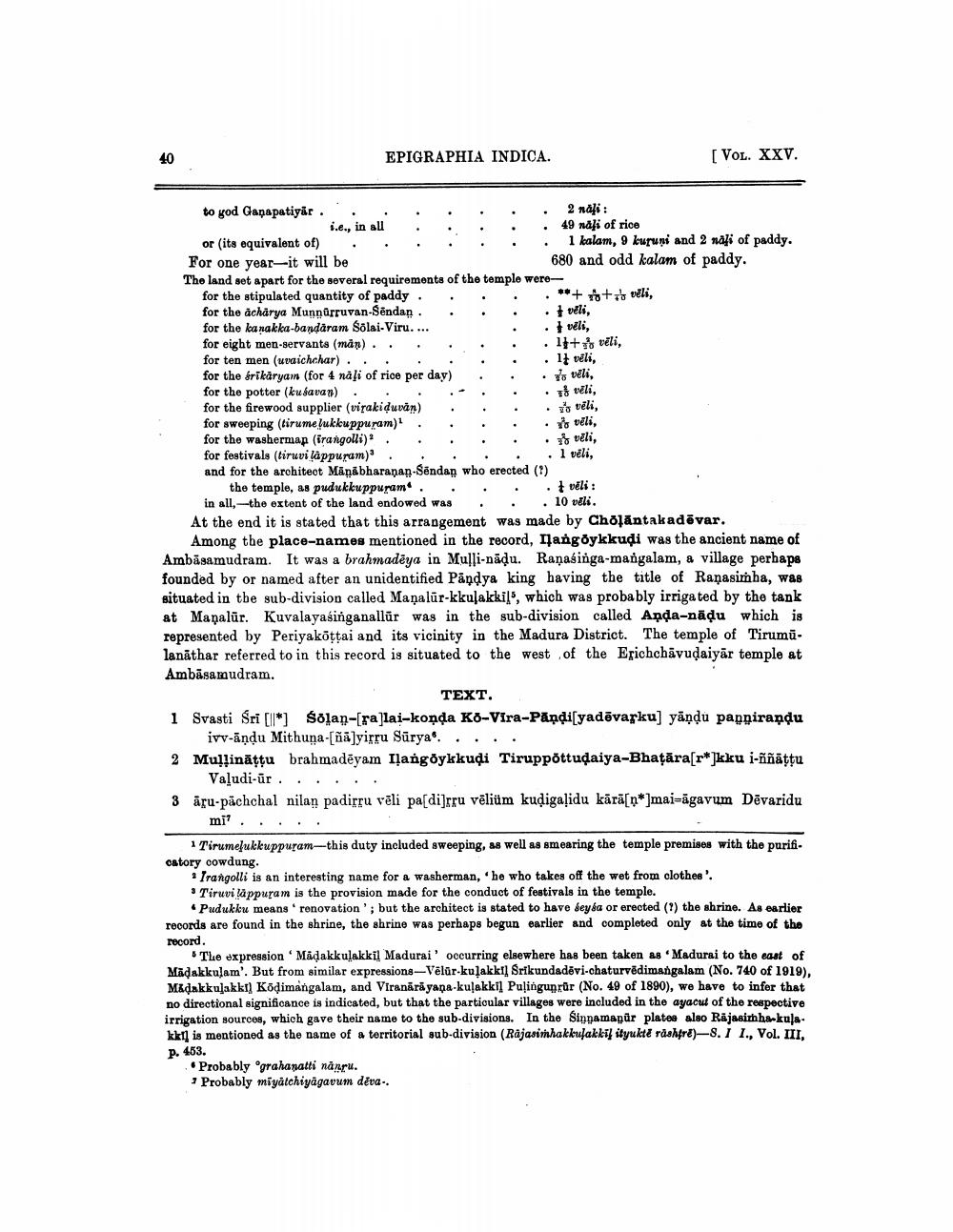________________
EPIGRAPHIA INDICA.
[VOL. XXV.
. 1 véli,
to yod Ganapatiyar . . . . . . . . 2 nafs :
i.e., in all . . . . 49 nafi of rice or (its equivalent of) . . . . . . . 1 kalam, 9 kuruni and 2 nafi of paddy. For one year-it will be
680 and odd kalam of paddy. The land set apart for the several requirements of the temple werefor the stipulated quantity of paddy. .
. **+ + vēli, for the acharya Munnurruvan-Sēndan. . . . vēli, for the kanakka-bandaram Solai-Viru....
. . veli, for eight men-servants (man) . . . . . . . 11+ vēli, for ten men (uvaichchar) . . . . . . 17 vēli, for the brikäryam (for 4 näļi of rice per day) . . . to veli, for the potter (kusavan) . . . . . . . veli, for the firewood supplier (virakiduvan) . . . . io vēli, for sweeping (firumefukkuppuram) . . . . .y véli, for the washermap (irangolli)' . .
. . veli, for festivals (tiruvi lappuram). . . and for the architeot Mäņābharaṇan-Sēndan who erected (?)
the temple, as pudukkuppuram . . . . . t veli: in all-the extent of the land endowed was . . . 10 vtli. At the end it is stated that this arrangement was made by Cholantakadēvar.
Among the place-namos mentioned in the record, Ilangöykkudi was the ancient name of Ambasamudram. It was a brahmadėya in Mulli-nādu. Ranasinga-mangalam, & village perhaps founded by or named after an unidentified Pandya king having the title of Ranasimha, was situated in the sub-division called Maņalūr-kkulakkils, which was probably irrigated by the tank at Manalür. Kuvalayasinganallur was in the sub-division called Anda-nadu which is represented by Periyaköttai and its vicinity in the Madura District. The temple of Tirumā. lanāthar referred to in this record is situated to the west of the Erichchāvudaiyar temple at Ambāsamudram.
TEXT. 1 Svasti Sri [ll] Śölan-[ra]lai-konda Ko-Vira-Pāņdi[yadēvarku) yāņņu papņirandu
ivv-āņdu Mithuna-[ñā]yirru Sürya..... 2 Mulļināțţu brahmadēyam langöykkuļi Tiruppóttudaiya-Bhatāra[r*]kku i-ññāttu
Valudi-ūr. ..... 3 áru-pächchal nilan padirru vēli pa[di]rru vēliüm kudigaļidu kārāsn*]mai=āgavum Dēvaridu
1 Tirumețukkuppuram-this duty included sweeping, as well as smearing the temple premises with the purifi. catory cowdung.
: Irangolli is an interesting name for a washerman, 'be who takes off the wet from clothes'. • Tiruvilappuram is the provision made for the conduct of festivals in the temple.
• Pudukku means renovation'; but the architect is stated to have seyda or erected (?) the shrine. As earlier records are found in the shrine, the shrine was perhaps begun earlier and completed only at the time of the record.
The expression Madakkulakkil Madurai' occurring elsewhere has been taken as Madurai to the east of Madakkulam'. But from similar expressions--Vēlür-kulakkil Srikundadovi.chaturvēdimangalam (No. 740 of 1919), Madakkulakkr) Ködimangalam, and Viranārāyana-kulakkil Puțingunrur (No. 49 of 1890), we have to infer that no directional significance is indicated, but that the particular villages were included in the ayacul of the respective irrigation sources, which gave their name to the sub-divisions. In the Sinnamapur plates also Rajasith ha-kulakki] is mentioned as the name of a territorial sub-division (Rajasinhakkulakkif ityukta rashprd)—8. 1 I., Vol. III, P. 453.
Probably grahanatti nänru. ? Probably miyatchiyagavum dēva -.




